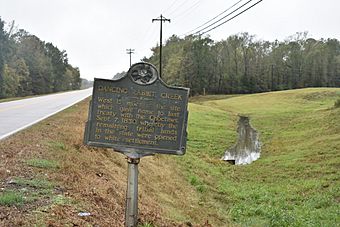Dancing Rabbit Creek Treaty Site facts for kids
|
Dancing Rabbit Creek Treaty Site
|
|

Historic marker for the Treaty of Dancing Rabbit Creek
|
|
| Nearest city | Macon, Mississippi |
|---|---|
| Area | 40 acres (16 ha) |
| Built | 1830 |
| NRHP reference No. | 73001024 |
Quick facts for kids Significant dates |
|
| Added to NRHP | April 3, 1973 |
| Designated NHL | June 19, 1996 |
The Dancing Rabbit Creek Treaty Site is a special historical place in Noxubee County, Mississippi. It's where the Choctaw Native American people used to gather. This site is near a fresh spring, close to Dancing Rabbit Creek.
In 1830, a very important meeting happened here. The Choctaw leaders and the United States government signed the Treaty of Dancing Rabbit Creek. In this treaty, the Choctaw agreed to give up their traditional lands. These lands were in what is now Mississippi, Alabama, and Louisiana. In return, they would move to new territory in what is now Oklahoma.
This treaty was the first one signed after a new law called the Indian Removal Act. This act allowed the government to move Native American tribes from their homes. The Dancing Rabbit Creek Treaty became a model for other treaties like it. It also led to the sad journey known as the Choctaw Trail of Tears. Today, a stone memorial and a small Choctaw cemetery mark this important site. It was named a National Historic Landmark in 1996.
Contents
What is the Dancing Rabbit Creek Treaty Site?
The Dancing Rabbit Creek Treaty Site is in a quiet, wooded area of southwestern Noxubee County. You can reach it by following Monument Road. A special marker and a cemetery show where the most important part of the site is. There are no old buildings left here today. However, when the treaty was signed, there was a Choctaw meeting house. This house was the main place for the discussions.
Why is the Site Important?
A granite marker was placed at the site in 1928. This was done by a local group called the Daughters of the American Revolution. Over time, this marker became a central spot for the Choctaw people. They began to hold special events here and even buried some of their loved ones nearby. The marker's location was chosen carefully. It was based on research from the late 1800s by Henry S. Halbert. He was a Choctaw historian who talked to people who remembered the treaty signing.
The Choctaw People and the Treaty
The Choctaw were one of the "Five Civilized Tribes" in the southeastern United States. They were called this because they had adopted some American customs. They also developed their own government system, including a constitution. Even with these changes, white settlers wanted their lands. The Choctaw had already given up some of their lands in the 1820s.
Why Did the Treaty Happen?
When Andrew Jackson became president in 1828, he wanted to move the Choctaw and other tribes. He wanted them to move to lands in what was then called the Indian Territory. This area is now the state of Oklahoma.
The treaty talks with the Choctaw took place from September 15 to 27, 1830. Thousands of Choctaw people gathered at the site. Government representatives, John H. Eaton and John Coffee, were also there.
The Treaty Signing and Its Impact
On September 22, many Choctaw people did not agree with the treaty being offered. A large number of them left the gathering over the next few days. Three main Choctaw chiefs eventually signed the treaty. The signing of the treaty was controversial and not all Choctaw agreed with it.
After the treaty, most of the Choctaw people were forced to move to Oklahoma. This happened between 1831 and 1833. This difficult journey is remembered as the Trail of Tears.
Images for kids




